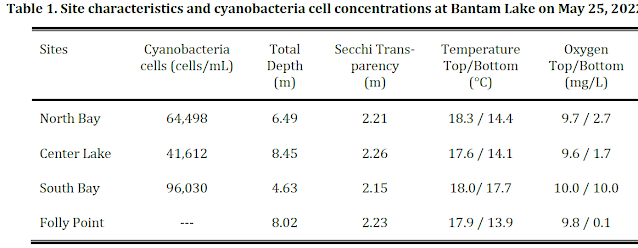Cyanos Activity May 25, 2023
Reconsider activities and limit exposure to the water.
Disclaimer: The information presented below reflects conditions throughout the lake and may differ from conditions on specific shorelines. For information regarding beach closings please contact the Torrington Area Health District or local town officials.
On Thursday, May 25th, Brawley Consulting Group visited Bantam Lake to conduct bi-weekly cyanobacteria monitoring as part of the 2023 lake management program. Water column profile data, total depth measurements, and Secchi transparency data were collected from the North Bay (NB) Site (N 41.71087° W -73.21155°), the Center Lake (CL) Site (N 41.70056° W -73.22102°), and the South Bay (SB) Site of the lake (N 41.69015 W -73.22728).
A plankton tow sample using a 10μm mesh plankton net was collected at the CL Site. The concentrated plankton sample was transferred into a 25mL glass amber bottle and stored at 3°C. Approximately 500 mL of the top three meters of water column was integrated and collected for algae counts at the North Bay, South Bay and Center Lake sites using a three-meter-long sampling tube. Those samples were preserved with Lugol’s solution shortly after collection and stored at 3C.
A portion of the live phytoplankton in the net sample was carefully examined with microscopy on the same day it was collected to identify and list all algal genera present prior to any treatment or preservation. Afterwards, the net sample was preserved with Lugol’s Solution and stored. The integrated whole water samples were prepared by applying hydrostatic pressure.
Cyanobacteria and Algae Community
Cyanobacteria continued to dominate the surface waters at Bantam Lake, but cell counts decreased precipitously since May 12th (Fig. 1). The greatest cyanobacteria cell concentrations were observed at the SB Site at 96,030 cells/mL; the concentration at the CL and NB Sites were lower at 41,612 and 64,498 cells/mL. All three cell concentrations were characteristic of Visual Rank Category 2 (moderate risk to public health) according to Connecticut’s guidance for municipalities (CT DPH & CT DEEP 2021). For such conditions, the State advises cautionary posting at public access points and notifying the CT DPH and CT DEEP.
The filamentous cyanobacteria Aphanizomenon spp. continued to dominate the phytoplankton accounting for 93 to 96% of all cells counted at each site. Other cyanophytes observed included Woronichinia spp., Dolichospermum spp., and Aphanocapsa spp. The number of different Chrysophyta (aka golden algae) observed in the net or whole water samples increased since May 12th and included Synura spp., Mallomonas spp., Dinobryon spp. and Uroglenopsis spp. The number of different genera of Bacillariophyta (aka diatoms) also increased from two on May 12th to six on May 25th. All golden algae and diatoms were comparatively rare relative to the abundance of cyanobacteria.
Water Quality
Secchi disk transparencies improved since May 12th and were between 2.15 and 2.16 on May 25th (Table 1; Fig. 2). The top three-meter average relative phycocyanin concentration exhibited a corresponding decrease. Phycocyanin is the photosynthetic pigment contain in cyanobacteria and surrogate of cyanobacteria biovolume. For comparative purposes, the lake average Secchi transparency and relative phycocyanin concentration from April 23rd to May 25th of 2023 were overlaid onto the plots of measurements from 2022.
Site Condition
The water columns at the NB and CL Sites were stratified, nearly stratified at the FP Site, and still mixed at the SB Site. Oxygen concentrations near the bottom were still high at the SB Site, nearly anoxic at the NB and CL Sites, and at anoxic levels at the FP Site (Table 1).
Conclusions
The public risk from cyanobacteria observed in Bantam Lake on May 25th was much improved on May 25th. The Visual Rank Category 3 conditions observed early this season were more consistent with Visual Rank Category 2 conditions. Other related variables measured, e.g., Secchi transparency and relative phycocyanin levels, also exhibited improvements.
Literature Cited
Connecticut Department of Public Health and Connecticut Department of Energy and Environmental Protection. 2019. Guidance to Local Health Departments for Blue–Green Algae Blooms in Recreational Freshwaters. See https://portal.ct.gov/-/media/Departments-and-Agencies/DPH/dph/environmental_health/BEACH/Blue-Green-AlgaeBlooms_June2019_FINAL.pdf?la=en
Analyses performed by Larry Marsicano, CLM, Brawley Consulting Group, LLC contracted by Bantam Lake Protective Association.





